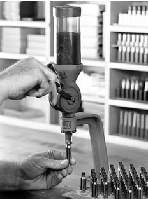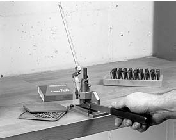Powder Charging
The primed case is now ready to be charged with powder. Begin by locating a suitable load from the reloading tables, and if a powder measure is to be used, filling the measure’s hopper with the appropriate propellant. After filling the hopper, the measure must be adjusted to throw the desired charge weight. This should be done according to the manufacturer’s instructions for the type of measure being used. Once the charge weight has been set, we recommend that an average charge be determined. Throw ten charges, operating the handle exactly as when charging cases, into the powder scale pan and weigh the total amount. This figure divided by ten will yield the average charge thrown. If this amount does not agree with the desired charge weight, you have further adjustment to do before charging cases. Once the appropriate charge has been adjusted, you’re ready to begin charging cases. The procedure will vary at this point, depending on the type of charge being thrown. The various types of powders each have their own unique characteristics, and some adjustment for these differences is required. Lets take a look at some of the variables that must be considered, before choosing our next step.

The powder charge is thrown directly from the measure. The measure shown here is a Redding 3 BR, a popular model among competitive shooters.
When throwing large charges of long-grained extruded tubular powders, you will soon find that operating the measure in a smooth and even manner is extremely difficult. Even when using the best quality powder measure, it is almost impossible to get heavy charges of powder such as H4831 and IMR-4350 to regularly throw charges within ± .5 grain. To assure the utmost consistency, many reloaders prefer to adjust their powder measures to throw a charge just a few tenths of a grain under the intended load. With a powder charge thrown directly into a scale pan, the charge is brought up to the correct weight with a powder dribbler. When the appropriate charge weight is reached, the case is charged from the scale pan with the aid of a powder funnel or drop tube. Although time consuming, this method does offer a good degree of safety when loading maximum or near maximum loads.

Priming cases with a bench-mounted RCBS priming tool.
Small to medium capacity cases can normally be charged directly from the powder measure, but the charge weight should be verified every few rounds to ensure that the measure setting has not changed. Ball or spherical powders are the easiest powders to work with in this regard, and flow through most powder measures quite well. Contrary to popular opinion, the shorter grained extruded tubular powders, such as 4895 (either Hodgdon or IMR), flow through most measures with acceptable uniformity. The real key here is to operate the measure in exactly the same manner each and every time a charge is thrown. Raise and lower the handle with the same degree of force, speed , and cadence every stroke and you will be surprised at how well these powders can be thrown. Proof of this can be found in the fact that very few competitive benchrest shooters bother with weighing their charges. The vast majority throw the charge directly into the case right from the measure. If you should see someone at a benchrest match carefully weighing each and every charge, chances are that he (or she) is a novice, and just hasn’t conceded to the wisdom of more experienced shooters. Try some different techniques with your measure, weighing the charges thrown to determine which works best for you. The goal here should be uniformity from throw to throw.
Even with their smaller charges, handgun cases can usually be charged directly from the measure. Most powder measures will hold charge to charge variation to within ± .2 of a grain quite easily, if they are operated with smooth and uniform strokes. Handgun cases in particular deserve special attention when charging, due to the many loads using small amounts of fast burning powders. Unlike most rifle loads, there is a great number of commonly used handgun cartridges that can easily contain double, triple, and even quadruple charges of powder. Those originally designed for use with black powder, such as the .45 Colt, are particularly troublesome in this regard. When cases that have the potential for being double charged are loaded, the charged cases should be examined carefully under a strong light. Case blocks holding the cases at evenly spaced intervals may be used to hold the cases during the charging process, and again to tilt them to an angle where the light can reach the powder. Holding the block so that the powder is clearly visible, scan the block slowly from case to case. Any that have been double charged should be readily noticeable by the different level of powder in relation to those on either side. If such a case is found, dump it out and rethrow the charge. As an extra precaution, we recommend dumping the cases charged immediately before and after the suspect case, and recharging them as well.
One trick that we’ve found useful for both rifle and handgun reloading is to monitor the quantity of powder you have on hand in each canister. At some point, you will find yourself wanting to load a quantity of ammunition, but unsure of having enough of a particular powder to accomplish it. There is a simple solution to this predicament, as long as it is instituted every time a new can of powder is opened. Before doing any reloading with a new can of powder, attach a label (the self-adhesive 3″ x 5″ labels at your local stationery store are ideal) to the side or back of it. At the top of the label, record the amount of powder, in grains, in the canister. This can be found by multiplying the powder’s weight in pounds by 7,000 (the number of grains in a pound).
From that point on, every time you reload, simply multiply the charge weight (in grains) by the number of rounds you reloaded. This will give you the amount of powder used in this particular reloading session. Subtract this amount from the total amount left in the can. By keeping a running total of the number of grains left in the can, you will be able to easily calculate whether or not you have sufficient powder for a planned reloading session. This takes very little time, and is much more positive than hefting the can, shaking it, and guessing how much powder you have left. An example: you wish to load two boxes (40 rounds) of once-fired .308 Winchester cases. The load you plan to use calls for 41.7 grains of IMR-4895, for a total powder requirement of 1,668.0 grains (41.7 x 40 = 1,668.0). Checking your label, you see that you have approximately 1,600 grains of powder left in the can, enough for only 38 rounds. By knowing this ahead of time, you will avoid running out of powder before your reloading session is complete. Otherwise, you may be forced to mix different lots of powder to finish the job, or load only a partial box of ammunition.
